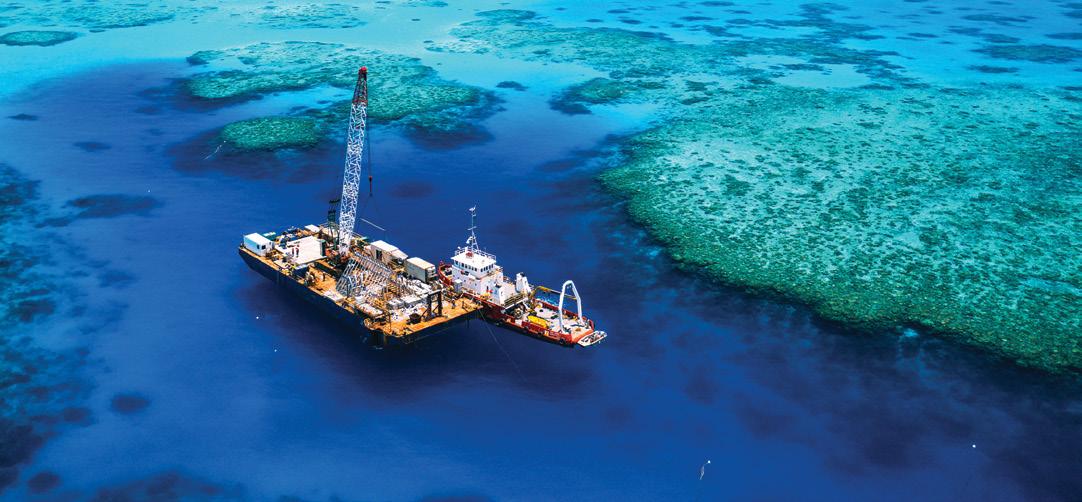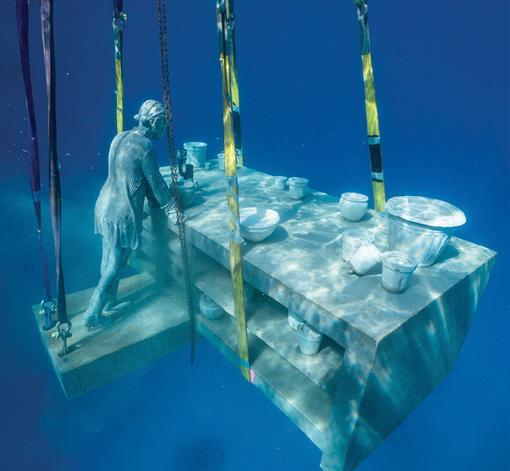
5 minute read
Welcome to the reef’s growing attraction
The first Museum of Underwater Art (MOUA) located on the Great Barrier Reef fits naturally into its underwater setting. For such a unique installation in an environmentally sensitive location, the long days of planning and risk assessment have made the complex project worthwhile.
By Simon Enticknap
Advertisement

Inspirational: Museum of Underwater Art on the Great Barrier Reef is an adventure for scuba divers.
Image supplied by Jason deCaires-Taylor
When completed, the overall museum will encompass several sites both above and below the waterline in the Townsville region, including proposed installations on Palm Island and Magnetic Island.
One of the first stages of the project to be completed is located at John Brewer Reef, in the Great Barrier Reef Marine Park, about 75 kilometres east of Townsville.
A large underwater sculpture of a coral greenhouse, complete with human figures, work benches and a garden, now sits in 16 metres of water right next to the reef, creating a delightful underwater encounter for divers.
Installing such a large structure in a protected marine environment required considerable pre-planning—not just in assessing the best location and any potential environmental impacts of the artwork, but also determining how to install it safely in an offshore location, and the impact that visitors may have on the area.
Dr Adam Smith, managing director of reef research group—Reef Ecologic— and MOUA deputy chair, played a lead role in the environmental impact assessment prior to the installation. He said a number of locations were assessed, but John Brewer Reef was chosen because it matched the criteria for having a relatively level, sandy seabed in a sheltered area, to provide protection against the weather for the artwork.
‘We did really well to find a site with flat sand to put the artwork on that is also surrounded by a fantastic healthy reef with a diverse fish community—people get to see world class art and a world class natural environment,’ Adam said.

Nature takes hold: where art and the marine environment meet
Image by Matt Curnock

Mastermind: Jason deCaires-Taylor at work
Image supplied by Jason deCaires-Taylor


Complex operation: the installation involved a careful risk assessment
Images supplied by Pacific Marine Group

Dream build: nature takes part in the setting
Image by Matt Curnock
Being so close to a healthy reef also posed challenges for the project team.
In preparation for the installation, site surveys were carried out to assess the potential impacts of the artwork and resulting visitors on the reef. These impacts included changes in natural lighting, noise, and water contamination such as oil spillage, in addition to the possible direct impact of vessel strikes. A magnetometry survey of the area also had to be carried out to look for unexploded ordnance leftover from World War II.
The sculpture was created by British artist Jason deCaires Taylor, world-renowned for his underwater sculptures, including the first underwater museum comprising over 800 sculptures at the Cancún Underwater Museum off the coast of Mexico.
Jason constructed the artwork out of stainless steel and concrete, which don’t leach out chemicals into the surrounding environment. Being lime-based, the concrete provides a settlement substrate for algae, coral and other invertebrates, which over time, will develop into an artificial reef and enhance the local marine habitat.
The artwork was also designed to withstand some of the most severe tropical storms in the region without disintegrating or being dislodged.
Local company Pacific Marine Group took the lead on installing the artwork. Using barge cranes, tugs and divers, the company planned to lower the greenhouse into the water in three stages, fixing it onto a concrete base.
It was a complex operation, supported by a comprehensive assessment of risks associated with different aspects of the operation, from lifting, vessel operations and the use of heavy machinery, to changing weather conditions, and even trips and falls. The mitigation approach was as extensive as the risk assessment itself, and included crew training, detailed briefing sessions and having qualified personnel on site at all times.

Careful: a worker secures the structure
Image by Jason deClaires-Taylor
The diving operations were also risk assessed to cover risks such as failure of breathing gas supply and possible shark encounters—all of which need to be monitored by deck crew.
According to Pacific Marine Group CEO Kevin Chard, the hardest risk to manage was the sea state—the combination of wind, waves and current, which impacted on safe anchoring in close proximity to the reef.
The barge and tugs were expected to be on the reef for up to a week, so it was important to have a period of calm weather with low winds in which to operate. Even then, the conditions were not always favourable.
‘On occasions the tug and barge had to leave the installation site and anchor wide of the reef in case the anchors dragged and damaged the installed works or— in a worst case scenario—resulted in a grounding on the reef,’ Mr Chard said.
The installation was completed in April 2020 and then officially opened in August with a small group of tourism operators licensed to take divers out to the site.
As part of the site’s management plan, the site will continue to be monitored for any potential impacts on the reef, from either the artwork or visitors. In the event of the artwork being damaged—such as in the aftermath of a cyclone—MOUA has planned for such a contingency by getting quotes for salvage and paying a bond to cover clean-up operations.
The artwork has a design life of up to 25 years and at some stage in the future a decision will be made to either leave it there or remove it. By that time, the greenhouse will be a very different place indeed.
Adam Smith said fish life started moving into the greenhouse from the beginning and it is already home to algae and soft sponges. Looking to accelerate the process of colonisation, MOUA has permission to collect up to 500 samples of dislodged coral and plant them in the greenhouse to encourage further development.
It is hoped then that over time, the Coral Greenhouse will truly live up to its name as a place of growth and regeneration.

A section of the installation is carefully lowered to the seafloor.
Image by Jason deCaires-Taylor

A diver explores the installation
Image by Jason deCaires-Taylor
Learn more about the Museum of Underwater Art at: moua.com.au








